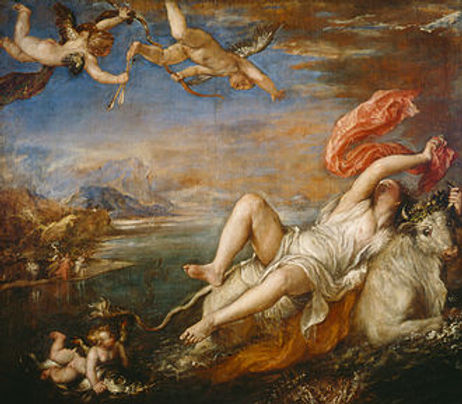<A>
art of the Franciscans (Cimabue, Giotto, Italian Gothic): *
Saint Francis of Assisi (1182-1226) was an Italian Catholic friar, deacon & preacher. He founded numerous holy orders (Friars Minor, Saint Clare, Third Order of Saint Francis, Custody of the Holy Land). He is one of the most venerated religious figures in history; in 1228 Pope Gregory IX canonized him & designated him as a Patron saint of Italy. His order promoted devotion to the saint’s life & commissioned large numbers of works for Franciscan churches, showing Saint Francis with sacred figures, or episodes from his life. The Basilica of Saint Francis in Assisi, is where Francis was born & died & where he is buried. It was begun in 1228 & is comprised of 2 churches (the Upper & Lower Churches or Basilicas). The interior of the Upper Church holds important early example of the Gothic style in Italy. In the period 1288-92, Cimabue worked in this church. In the transept of the Lower Basilica he painted the frescos Madonna with Child Enthroned, Four Angels and St Francis. He was later commissioned to decorate the apse & transept of the Upper Basilica. The cycle he created was made up from the Gospels, the lives of the Virgin Mary, St Peter and St Paul. The most important decorations in the Upper Basilica are the 28 frescoes by a young Giotto along the lower part of the nave. Each bay contains 3 frescoes above the dado on each side of the nave, 2 frescoes in the east galleries beside the entrance, and 2 more on the entrance wall. Giotto used the Legenda Maior (the biography of Saint Francis by Saint Bonaventure) to reconstruct events in the life of Saint Francis. The paintings are as vivid as if Giotto had been a witness to these events. Vasari dates them between 1296 and 1304.
<B>
Perugino (drapery): *
The Delivery of the Keys fresco, 1481–1482, Sistine Chapel, Rome.
The style of the figures is inspired by Verrocchio. The active drapery, with its massive complexity, and the figures, particularly several apostles, including St. John the Evangelist, with beautiful features, long flowing hair, elegant demeanour, and refinement recall St Thomas from Verrocchio's bronze group in Orsanmichele. The poses of the actors fall into a small number of basic attitudes that are consistently repeated, usually in reverse from one side to the other, signifying the use of the same cartoon. They are graceful and elegant figures who tend to stand firmly on the earth.

detail from above, showing the drapery

<C>
Titian (late works, individual brush strokes): *
T
The Rape of Europa c. 1560–1562
The title refers to the mythological story of the abduction of Europa by Zeus. Titian is unequivocal about the fact that this is a scene of rape (abduction): Europa is sprawled helplessly on her back, her clothes in disarray. In the myth, the god assumed the form of a bull and enticed Europa to climb onto his back. Once there, the bull rode into the sea and carried her to Crete, where he revealed his real identity. Europa became the first Queen of Crete, and had three children with Zeus. The painting depicts Europa on the back of the bull, just off the shore of her homeland. It is a bold diagonal composition. In contrast to the clarity of Titian's early works, it is almost baroque in its blurred lines, swirling colours & vibrant brushstrokes.

<D>
Monteverde (orchestra-colours): *